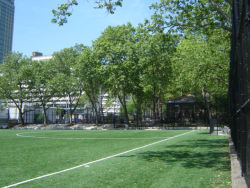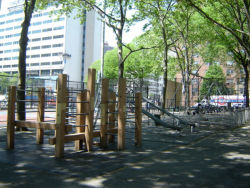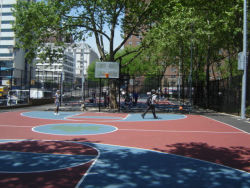McLaughlin Park
McLaughlin Park
What was here before?
Lenape Native Americans originally inhabited the area, later known as Breuckelen after the arrival of the Dutch in the 1600s. In 1755, Barent Johnson purchased 40 acres roughly between Tillary and Willoughby Streets. When Johnson died in 1777 of wounds incurred fighting on the American side in the Battle of Long Island, his land passed to his son, John Barent (J.B.) Johnson. J.B. Johnson, a Dutch Reformed Minister, had three children with his wife Elizabeth Lupton Johnson. Upon both their death in 1803 of tuberculosis, their children became heirs to the large tract of land in a quickly growing Brooklyn and started building houses and selling land in the mid-1820s.
The Johnsons were integral in the development of this area of Brooklyn. Four houses remain from this era--the Duffield Houses. Once located on Johnson Street, they were moved in 1990 to their present site on Duffield Street as part of MetroTech redevelopment plan.
How did this site become a playground?
McLaughlin Park was acquired by condemnation in 1884 and was named by the Board of Aldermen for Hugh McLaughlin Jr. (1823-1904) in 1905.
The park was rebuilt in 2006 and includes two basketball courts with bleachers and recreational lighting, a reconstructed handball court, areas designated for exercise equipment, a spray shower with a steamboat theme, and a synthetic turf multi-purpose area for softball and soccer. In addition, the reconstruction includes new benches, fencing, drinking fountains, and a variety of plants, trees and shrubs.
A limestone monument to local fallen WWI soldiers stands in the southeast corner of the park.
Who is this park named for?
Hugh McLaughlin, Jr. was a local civic leader with tremendous influence in Brooklyn politics and in the religious life of his community as devout Catholic. He was the youngest of ten children born to Irish immigrants who arrived in Brooklyn early in the 19th century. McLaughlin began his career as a fishmonger and later became the master foreman at the Brooklyn Navy Yard in Fort Greene. An astute businessman, McLaughlin eventually amassed a fortune through successful real estate speculation.
McLaughlin developed an interest in politics early in life, and his position of respect among working class citizens made him an asset to the Democratic Party. Although he lost the Kings County Sheriff’s election in 1860, McLaughlin served three terms as the Registrar of Kings County, beginning in 1861. For nearly 50 years, McLaughlin dominated Brooklyn politics, fighting against both Tammany Hall and the City of Brooklyn’s incorporation into the City of New York. He continued to participate in City Hall business even after his official retirement, earning him the affectionate title “The Sage of Willoughby Street.”
According to some sources, McLaughlin paid for the burials of most of the poor Irish in Brooklyn at the end of the 19th century, but his modesty prevented him from making his generosity known before his death. Following his death in 1904, his wife, a convert to Catholicism, received the title of Marchioness from the Pope and raised the funds necessary to build the Church of St. Hugh in Huntington, Long Island in her husband’s memory.
Check out your park's Vital Signs
Clean & Safe
Green & Resilient
Empowered & Engaged Users
Share your feedback or learn more about how this park is part of a
Vital Park System



